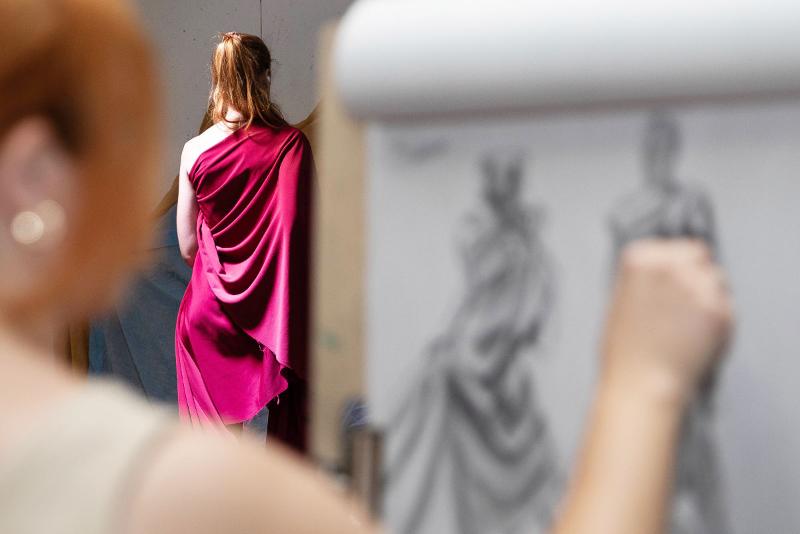Art models, like Alexandria Anderson-Whittaker, are essential members of the art education team, supporting students in their understanding of the complexities of the human figure. In this article, we explore how art models contribute to students' artistic development, their role in teaching principles such as anatomy and proportion, and the impact they have on various majors like fine arts, illustration, visual studies, computer animation, and game design.
The Importance of Art Models in Figure Drawing
Discover how art models contribute to the development of artists' understanding of the human figure.
Art models, like Alexandria Anderson-Whittaker, play a vital role in figure drawing classes. Their poses provide valuable reference material that allows students to deepen their understanding of the complexities of the human figure. Through carefully crafted poses, art models help artists capture the curves, shapes, and proportions of the human form.
By observing the subtle nuances of the model's body language and gestures, students are able to develop their skills in translating life-like gestures into their artwork. Art models give students the opportunity to practice capturing an array of body positions, improving their ability to represent movement and create expressive and accurate drawings.
Furthermore, art models bring a sense of depth and humanity into the classroom. Their presence adds life and realism to the artistic process, teaching students not only how to draw the human figure physically but also the importance of capturing emotion, energy, and the unique individuality of each model.
Expanding Anatomy and Proportion Understanding
Explore how art models facilitate students' learning of anatomical structure and proportions in various artistic disciplines.
Understanding human anatomy and proportion is crucial for various artistic disciplines, including visual studies, computer animation, game design, and fine arts. Art models provide a valuable opportunity for students to observe and study the intricate details of the human body up close.
By carefully examining the various parts of the model's body, students can learn to accurately capture the proportions and relations between different body elements. From depicting facial expressions to the fine manipulations of hands and feet, art models help students build a strong foundation in anatomical accuracy, enabling them to create more lifelike and impactful artwork.
Enhancing Technical Skills in Rapid Image Creation
Discover why art models are crucial for animators and game designers, who need to produce images quickly and accurately.
Animators and game designers often need to create multiple images in rapid succession, requiring them to work quickly and accurately. Art models are essential in helping these students to refine their technical skills in capturing the human figure efficiently.
By immersing themselves in drawing from life models, animators and game designers can improve their ability to accurately depict anatomical structure and movement. The practice gained from working with art models allows them to produce solid foundations and strong character designs, adding authenticity and credibility to their animations and games.
Art models’ versatile poses provide animators and game designers with the valuable opportunity to experiment with different angles, explore foreshortening, and understand how bodies interact with the environment. Through these studies, they refine their skills in portraying storylines and conveying emotions effectively.
Models as Muse: Building Confidence Through Art
Learn how art models contribute to personal growth and body confidence for both models and students.
While art models crucially aid artistic education, they also provide an opportunity for personal growth and building body confidence. Many individuals are drawn to modeling as an avenue for exploring their own bodies and finding comfort in their skin.
Art models create safe spaces that encourage body positivity and acceptance. Through their consistent presence in art classes, models inspire individuals to appreciate the diverse range of human body types, celebrating the uniqueness and beauty of every form. Artists often utilize their skills to capture the confidence and vulnerability of the models, breaking societal norms and expressing different narratives of body experiences.
Conclusion
Art models play a vital role in supporting art education by providing valuable references for artists to study and practice their skills. From figure drawing to understanding anatomy and proportions, art models contribute to the artistic development of students across various disciplines.
In addition, art models empower individuals to appreciate body diversity and promote body confidence. They create a positive and inclusive environment for artists to explore the beauty and uniqueness of the human form.
With their incredible ability to hold poses and bring life to the classroom, art models deserve recognition for their invaluable contribution. Their presence enriches the artistic experience and ensures that future artists have the skills to accurately and expressively portray the human figure.
FQA :
What is the role of art models in art education?
Art models serve as references for artists, helping them understand the complexities and nuances of the human figure. They support the development of technical skills and provide inspiration for creative expression.
What disciplines benefit from working with art models?
Various disciplines, including fine arts, illustration, visual studies, computer animation, and game design, benefit from working with art models. These models help students grasp anatomical structure, proportions, and develop their ability to create realistic and visually compelling artwork.
How do art models contribute to personal growth and confidence?
Art models create safe and inclusive spaces to celebrate and appreciate body diversity. They inspire individuals, both models and artists, to feel more confident and comfortable with their bodies while challenging societal norms and stereotypes.
Do all art classes require the use of art models?
While not all art classes require art models, they are particularly important in figure drawing classes, where studying and capturing the human form is essential. Additionally, for disciplines like character animation or anatomical studies, the use of art models is highly valuable.
Why is understanding anatomy and proportion important in art?
Understanding anatomy and proportion is fundamental in creating accurate and impactful art. It allows artists to depict believable and realistic figures, ensuring proper proportions and giving their artwork a strong foundation.

